| Revision as of 12:39, 21 July 2021 editGreenC bot (talk | contribs)Bots2,585,782 edits Rescued 1 archive link. Wayback Medic 2.5← Previous edit | Revision as of 10:33, 30 July 2021 edit undoGlottran (talk | contribs)Extended confirmed users12,532 edits →ClimateNext edit → | ||
| Line 58: | Line 58: | ||
| ==Climate== | ==Climate== | ||
| Robinson Crusoe has a ] climate, moderated by the cold ], which flows to the east of the island, and the southeast ]. Temperatures range from {{convert|3|C|F|0}} to {{convert|34|C|F|0}}, with an annual mean of {{convert|15.4|C|F|0}}. Higher elevations are generally cooler, with occasional frosts. Rainfall is greater in the winter months, and varies with elevation and exposure; elevations above {{convert|500|m|ft|0|abbr=on}} experience almost daily rainfall, while the western, ] side of the island is lower and drier.<ref> Corporacion Nacional Forestal de Chile (2010). Retrieved 27 May 2010. {{webarchive |url=https://web.archive.org/web/20120823132640/http://www.conaf.cl/parques/ficha-parque_nacional_archipielago_de_juan_fernandez-35.html |date=August 23, 2012 }}</ref> | Robinson Crusoe has a ] climate, moderated by the cold ], which flows to the east of the island, and the southeast ]. Temperatures range from {{convert|3|C|F|0}} to {{convert|34|C|F|0}}, with an annual mean of {{convert|15.4|C|F|0}}. Higher elevations are generally cooler, with occasional frosts. Rainfall is greater in the winter months, and varies with elevation and exposure; elevations above {{convert|500|m|ft|0|abbr=on}} experience almost daily rainfall, while the western, ] side of the island is lower and drier.<ref> Corporacion Nacional Forestal de Chile (2010). Retrieved 27 May 2010. {{webarchive |url=https://web.archive.org/web/20120823132640/http://www.conaf.cl/parques/ficha-parque_nacional_archipielago_de_juan_fernandez-35.html |date=August 23, 2012 }}</ref> | ||
| <div style="width:85%;"> | |||
| {{Weather box|location = San Juan Bautista, Chile | |||
| |metric first = yes | |||
| |single line = yes | |||
| |Jan high C = 22 | |||
| |Feb high C = 22 | |||
| |Mar high C = 21 | |||
| |Apr high C = 20 | |||
| |May high C = 18 | |||
| |Jun high C = 16 | |||
| |Jul high C = 15 | |||
| |Aug high C = 15 | |||
| |Sep high C = 15 | |||
| |Oct high C = 16 | |||
| |Nov high C = 18 | |||
| |Dec high C = 20 | |||
| |year high C = 18.2 | |||
| |Jan low C = 15 | |||
| |Feb low C = 16 | |||
| |Mar low C = 15 | |||
| |Apr low C = 13 | |||
| |May low C = 12 | |||
| |Jun low C = 11 | |||
| |Jul low C = 10 | |||
| |Aug low C = 9 | |||
| |Sep low C = 9 | |||
| |Oct low C = 10 | |||
| |Nov low C = 12 | |||
| |Dec low C = 13 | |||
| |year low C = 12.1 | |||
| |rain colour = green | |||
| |Jan rain mm = 22 | |||
| |Feb rain mm = 33 | |||
| |Mar rain mm = 40 | |||
| |Apr rain mm = 90 | |||
| |May rain mm = 151 | |||
| |Jun rain mm = 159 | |||
| |Jul rain mm = 167 | |||
| |Aug rain mm = 114 | |||
| |Sep rain mm = 78 | |||
| |Oct rain mm = 57 | |||
| |Nov rain mm = 37 | |||
| |Dec rain mm = 28 | |||
| |Jan rain days = 11 | |||
| |Feb rain days = 10 | |||
| |Mar rain days = 13 | |||
| |Apr rain days = 15 | |||
| |May rain days = 21 | |||
| |Jun rain days = 23 | |||
| |Jul rain days = 21 | |||
| |Aug rain days = 19 | |||
| |Sep rain days = 16 | |||
| |Oct rain days = 14 | |||
| |Nov rain days = 10 | |||
| |Dec rain days = 10 | |||
| |unit rain days = 0.1 mm | |||
| |Jan humidity = 73 | |||
| |Feb humidity = 73 | |||
| |Mar humidity = 73 | |||
| |Apr humidity = 77 | |||
| |May humidity = 78 | |||
| |Jun humidity = 78 | |||
| |Jul humidity = 79 | |||
| |Aug humidity = 77 | |||
| |Sep humidity = 77 | |||
| |Oct humidity = 76 | |||
| |Nov humidity = 74 | |||
| |Dec humidity = 73 | |||
| |Jan sun = 248.0 | |||
| |Feb sun = 209.0 | |||
| |Mar sun = 158.1 | |||
| |Apr sun = 123.0 | |||
| |May sun = 108.5 | |||
| |Jun sun = 99.0 | |||
| |Jul sun = 93.0 | |||
| |Aug sun = 105.4 | |||
| |Sep sun = 147.0 | |||
| |Oct sun = 204.6 | |||
| |Nov sun = 249.0 | |||
| |Dec sun = 260.4 | |||
| |source 1 = Climate & Temperature<ref>{{cite web | |||
| | url = http://www.climatetemp.info/juan-fernandez-islands/ | |||
| | title = San Juan Bautista Climate Guide to the Average Weather & Temperatures with Graphs Elucidating Sunshine and Rainfall Data & Information about Wind Speeds & Humidity: | |||
| | access-date = 2010-03-06 | publisher = Climate & Temperature | |||
| }}</ref> | |||
| |date=August 2010 | |||
| }} | |||
| </div> | |||
| ==Flora and fauna== | ==Flora and fauna== | ||
Revision as of 10:33, 30 July 2021
Island of Chile This article is about the Chilean island. For the island in Fiji, see Robinson Crusoe Island (Fiji). For the Arkady Fiedler novel, see Robinson Crusoe Island (novel).| Native name: Isla Robinson Crusoe | |
|---|---|
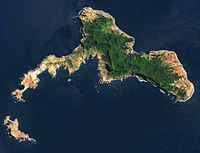 Satellite image of Robinson Crusoe Island Satellite image of Robinson Crusoe Island | |
 | |
| Geography | |
| Coordinates | 33°38′29″S 78°50′28″W / 33.64139°S 78.84111°W / -33.64139; -78.84111 |
| Type | Shield Volcanoes (last eruption in 1835) |
| Archipelago | Juan Fernández Islands |
| Adjacent to | Pacific Ocean |
| Area | 47.94 km (18.51 sq mi) |
| Highest elevation | 915 m (3002 ft) |
| Highest point | El Yunque |
| Administration | |
| Chile | |
| Region | Valparaíso |
| Province | Valparaíso Province |
| Commune | Juan Fernández Islands |
| Demographics | |
| Population | 843 (2012) |
Robinson Crusoe Island (Template:Lang-es, Template:IPA-es), formerly known as Más a Tierra (lit. 'Closer to Land'), is the second largest of the Juan Fernández Islands, situated 670 km (362 nmi; 416 mi) west of San Antonio, Chile, in the South Pacific Ocean. It is the more populous of the inhabited islands in the archipelago (the other being Alejandro Selkirk Island), with most of that in the town of San Juan Bautista at Cumberland Bay on the island's north coast.
From 1704 to 1709, the island was home to the marooned sailor Alexander Selkirk, who at least partially inspired novelist Daniel Defoe's fictional Robinson Crusoe in his 1719 novel, although the novel is explicitly set in the Caribbean. This was just one of several survival stories from the period of which Defoe would have been aware. To reflect the literary lore associated with the island and attract tourists, the Chilean government renamed the place Robinson Crusoe Island in 1966.
Geography
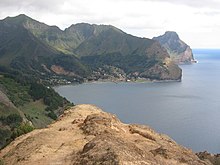
Robinson Crusoe Island has a mountainous and undulating terrain, formed by ancient lava flows which have built up from numerous volcanic episodes. The highest point on the island is 915 m (3,002 ft) above sea level at El Yunque. Intense erosion has resulted in the formation of steep valleys and ridges. A narrow peninsula is formed in the southwestern part of the island called Cordón Escarpado. The island of Santa Clara is located just off the southwest coast.
Robinson Crusoe Island lies to the west of the boundary between the Nazca Plate and the South American Plate, and rose from the ocean 3.8 – 4.2 million years ago. A volcanic eruption on the island was reported in 1743 from El Yunque, but this event is uncertain. On 20 February 1835, a day-long eruption began from a submarine vent 1.6 kilometres (1.0 mi) north of Punta Bacalao. The event was quite minor—only a Volcanic Explosivity Index 1 eruption—but it produced explosions and flames that lit up the island, along with tsunamis.
Climate
Robinson Crusoe has a subtropical climate, moderated by the cold Humboldt Current, which flows to the east of the island, and the southeast trade winds. Temperatures range from 3 °C (37 °F) to 34 °C (93 °F), with an annual mean of 15.4 °C (60 °F). Higher elevations are generally cooler, with occasional frosts. Rainfall is greater in the winter months, and varies with elevation and exposure; elevations above 500 m (1,640 ft) experience almost daily rainfall, while the western, leeward side of the island is lower and drier.
| Climate data for San Juan Bautista, Chile | |||||||||||||
|---|---|---|---|---|---|---|---|---|---|---|---|---|---|
| Month | Jan | Feb | Mar | Apr | May | Jun | Jul | Aug | Sep | Oct | Nov | Dec | Year |
| Mean daily maximum °C (°F) | 22 (72) |
22 (72) |
21 (70) |
20 (68) |
18 (64) |
16 (61) |
15 (59) |
15 (59) |
15 (59) |
16 (61) |
18 (64) |
20 (68) |
18.2 (64.8) |
| Mean daily minimum °C (°F) | 15 (59) |
16 (61) |
15 (59) |
13 (55) |
12 (54) |
11 (52) |
10 (50) |
9 (48) |
9 (48) |
10 (50) |
12 (54) |
13 (55) |
12.1 (53.8) |
| Average rainfall mm (inches) | 22 (0.9) |
33 (1.3) |
40 (1.6) |
90 (3.5) |
151 (5.9) |
159 (6.3) |
167 (6.6) |
114 (4.5) |
78 (3.1) |
57 (2.2) |
37 (1.5) |
28 (1.1) |
976 (38.5) |
| Average rainy days (≥ 0.1 mm) | 11 | 10 | 13 | 15 | 21 | 23 | 21 | 19 | 16 | 14 | 10 | 10 | 183 |
| Average relative humidity (%) | 73 | 73 | 73 | 77 | 78 | 78 | 79 | 77 | 77 | 76 | 74 | 73 | 76 |
| Mean monthly sunshine hours | 248.0 | 209.0 | 158.1 | 123.0 | 108.5 | 99.0 | 93.0 | 105.4 | 147.0 | 204.6 | 249.0 | 260.4 | 2,005 |
| Source: Climate & Temperature | |||||||||||||
Flora and fauna
The Fernandezian Region is a floristic region which includes the Juan Fernández Islands archipelago. It is in the Antarctic Floristic Kingdom, but often also included within the Neotropical Kingdom. As World Biosphere Reserves since 1977, these islands have been considered of maximum scientific importance because of the endemic plant families, genera, and species of flora and fauna. Out of 211 native plant species, 132 (63%) are endemic, as well as more than 230 species of insects.
Robinson Crusoe Island has one endemic plant family, Lactoridaceae. The Magellanic penguin is also found there. The Juan Fernández firecrown is an endemic and critically endangered red hummingbird, which is best known for its needle-fine black beak and silken feather coverage. The Masatierra petrel is named after the island's former name. The island (along with neighbouring Santa Clara) has been recognised as an Important Bird Area (IBA) by BirdLife International because it supports populations of Masatierra petrels, pink-footed shearwaters, Juan Fernandez firecrowns and Juan Fernandez tit-tyrants.
 Robinson Crusoe Island, seen from CS Responder during work on nuclear test ban hydroacoustic monitoring station in 2014.
Robinson Crusoe Island, seen from CS Responder during work on nuclear test ban hydroacoustic monitoring station in 2014.
History
The island was first named Juan Fernandez Island after Juan Fernández, a Spanish sea captain and explorer who was the first to land there in 1574. It was also known as Más a Tierra. There is no evidence of an earlier discovery either by Polynesians, despite the proximity to Easter Island, or by Native Americans.
From 1681 to 1684, a Miskito man known as Will was marooned on the island. Twenty years later, in 1704, the sailor Alexander Selkirk was also marooned there, living in solitude for four years and four months. Selkirk had been gravely concerned about the seaworthiness of his ship, Cinque Ports (which ended up sinking very shortly after), and declared his wish to be left on the island during a mid-voyage restocking stop. His captain, Thomas Stradling, a colleague on the voyage of privateer and explorer William Dampier, was tired of his dissent and obliged. All Selkirk had left with him was a musket, gunpowder, carpenter's tools, a knife, a Bible, and some clothing. The story of Selkirk's rescue is included in the 1712 book A Voyage to the South Sea, and Round the World by Edward Cooke.
In an 1840 narrative, Two Years Before the Mast, Richard Henry Dana, Jr. described the port of Juan Fernandez as a young prison colony. The penal institution was soon abandoned and the island again uninhabited before a permanent colony was eventually established in the latter part of the 19th century. Joshua Slocum visited the island between 26 April and 5 May 1896, during his solo global circumnavigation on the sloop Spray. The island and its 45 inhabitants are referred to in detail in Slocum's memoir, Sailing Alone Around the World.
World War I

During World War I, Vice Admiral Maximilian von Spee's German East Asia Squadron stopped and re-coaled at the island 26–28 October 1914, four days before the Battle of Coronel. While at the island, the admiral was unexpectedly rejoined by the armed merchant cruiser Prinz Eitel Friedrich, which he had earlier detached to attack Allied shipping in Australian waters. On 9 March 1915 SMS Dresden, the last surviving cruiser of von Spee's squadron after his death at the Battle of the Falklands, returned to the island's Cumberland Bay, hoping to be interned by the Chilean authorities. Caught and fired upon by a British squadron at the Battle of Más a Tierra on 14 March, the ship was scuttled by its crew.
2010 tsunami
On 27 February 2010 Robinson Crusoe Island was hit by a tsunami following a magnitude 8.8 earthquake. The tsunami was about 3 m (10 ft) high when it reached the island. Sixteen people lost their lives, and most of the coastal village of San Juan Bautista was washed away. The only warning the islanders had came from a 12-year-old girl, who noticed the sudden drawback of the sea that forewarns of the arrival of a tsunami wave and saved many of her neighbours from harm.
Society
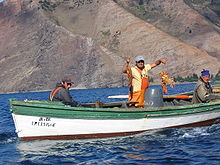
Robinson Crusoe had an estimated population of 843 in 2012. Most of the island's inhabitants live in the village of San Juan Bautista on the north coast at Cumberland Bay. Although the community maintains a rustic serenity dependent on the spiny lobster trade, residents employ a few vehicles, a satellite Internet connection and televisions. The main airstrip, Robinson Crusoe Airfield, is located near the tip of the island's southwestern peninsula. The flight from Santiago de Chile is just under three hours. A ferry runs from the airstrip to San Juan Bautista.
Tourists number in the hundreds per year. One activity gaining popularity is scuba diving, particularly on the wreck of the German light cruiser Dresden, which was scuttled in Cumberland Bay during World War I.
Maya statue hypothesis
A History Channel documentary was filmed on Robinson Crusoe Island. It aired on 3 January 2010 and showed two rock formations that Canadian explorer Jim Turner claimed were badly degraded Mayan statues. With no other sign of any pre-Columbian human presence on the island, however, the program has been criticized as lacking in scientific credibility.
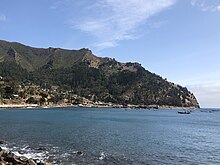

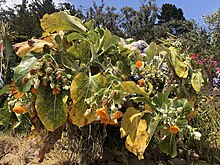
See also
References
- ^ Torres Santibáñez, Hernán; Torres Cerda, Marcela (2004). Los parques nacionales de Chile: una guía para el visitante (in Spanish). Editorial Universitaria. p. 49. ISBN 978-956-11-1701-3.
- ^ "Censos de poblacion y vivienda". Instituto Nacional de Estadísticas (2012). Retrieved 2 January 2013.
- ^ Severin, Tim (2002). In Search of Robinson Crusoe. New York: Basic Books. pp. 23–24. ISBN 978-046-50-7698-7.
- Severin, Tim (2002). In Search of Robinson Crusoe. New York: Basic Books. pp. 17–19. ISBN 978-046-50-7698-7.
- Little, Becky (28 September 2016). "Debunking the Myth of the 'Real' Robinson Crusoe". National Geographic. Retrieved 30 September 2016.
- "Parque Nacional Archipiélago de Juan Fernández" Corporacion Nacional Forestal de Chile (2010). Retrieved 27 May 2010. Archived August 23, 2012, at the Wayback Machine
- "San Juan Bautista Climate Guide to the Average Weather & Temperatures with Graphs Elucidating Sunshine and Rainfall Data & Information about Wind Speeds & Humidity:". Climate & Temperature. Retrieved 2010-03-06.
- ^ "Forest on Robinson Crusoe Island". Wondermondo (2012). Retrieved 18 October 2012.
- Hogan, C. Michael (2008). Magellanic Penguin. GlobalTwitcher. Retrieved 18 October 2012.
- "Islas Robinson Crusoe and Santa Clara". BirdLife Data Zone. BirdLife International. 2021. Retrieved 22 January 2021.
- "Welcome Back HA03—Robinson Crusoe Island", Preparatory Commission for the Comprehensive Nuclear-Test-Ban Treaty Organization (2014). Retrieved 5 April 2014.
- ^ Anderson, Atholl; Haberle, Simon; Rojas, Gloria; Seelenfreund, Andrea; Smith, Ian & Worthy, Trevor (2002). An Archeological Exploration of Robinson Crusoe Island, Juan Fernandez Archipelago, Chile. New Zealand Archaeological Association.
- Rogers, Woodes (1712). A Cruising Voyage Round the World: First to the South-seas, Thence to the East-Indies, and Homewards by the Cape of Good Hope. London: A. Bell and B. Lintot. pp. 125–126.
- Dana, Richard Henry (1840). Two Years Before the Mast: A Personal Narrative of Life at Sea. New York: Harper & Brothers. pp. 28–32.
- Coulter, John (1845). Adventures in the Pacific: With Observations on the Natural Productions, Manners and Customs of the Natives of the Various Islands. London: Longmans, Brown & Co. pp. 32–33.
- Slocum, Joshua (2012). Sailing Alone Around the World. Oxford: Beaufoy Publishing. pp. 77–82. ISBN 978-190-67-8034-0.
- ^ Delgado, James P. (2004). Adventures of a Sea Hunter: In Search of Famous Shipwrecks. Vancouver: Douglas & McIntyre. pp. 168–174. ISBN 978-1-926685-60-1.
- Ricketts, Colin (17 August 2011). "Tsunami warning came too late for Robinson Crusoe Island". Earth Times. Retrieved 18 October 2012.
- ^ Bodenham, Patrick (09 December 2010). "Adrift on Robinson Crusoe Island, the forgotten few". The Independent. Retrieved 7 April 2014.
- Harrell, Eben (2 March 2010). "Chile's president: Why did tsunami warnings fail?". Time Magazine. Retrieved 4 March 2010.
- ^ Gordon, Nick (14 December 2004). "Chile: The real Crusoe had it easy". The Telegraph. Retrieved 18 October 2012.
- "Armageddon: Apocalypse Island". A&E Television Networks (2009). Retrieved 18 October 2012. Archived January 13, 2012, at the Wayback Machine
- Lowry, Brian (26 June 2010). "Wackadoodle Demo Widens". Variety. Retrieved 9 February 2014.
Further reading
- Perez Ibarra, Martin (2014). Señales del Dresden (in Spanish). Chile: Uqbar Editores. ISBN 978-956-9171-36-9. The story of German light cruiser Dresden which was scuttled in this island during World War I.
External links
- Routes around the island with descriptions and photos of sights
- Robinson Crusoe Island satellite map with anchorages and other ocean-related information
- A detailed map of the island showing footpaths and walkers' refuges
- Juan Fernandez photo gallery with images of landscapes, flora and fauna on the island
- "Robinson Crusoe, Moai Statues and the Rapa Nui: the Stories of Chile’s Far-Off Islands" from Sounds and Colours
- A digital field trip to Robinson Crusoe Island by Goat Island Images
- "Chasing Crusoe", a multimedia documentary about the island
| Eastern Pacific islands | |
|---|---|
| Oceanic islands located between Polynesia and the Americas, sorted by country, from north to south (excluding continental islands) | |
| Mexico | |
| France | |
| Costa Rica | |
| Colombia | |
| Ecuador | |
| Chile | |
| Daniel Defoe's Robinson Crusoe | |
|---|---|
| Characters | |
| Sequel novels | |
| Films |
|
| Film variations |
|
| Television |
|
| Literature | |
| Other | |
- Robinson Crusoe Island
- Biosphere reserves of Chile
- Former penal colonies
- Juan Fernández Islands
- Islands of Valparaíso Region
- Flora of the Juan Fernández Islands
- Endemic flora of the Juan Fernández Islands
- Endemic fauna of the Juan Fernández Islands
- Prison islands
- Important Bird Areas of the Juan Fernández Islands
- Seabird colonies